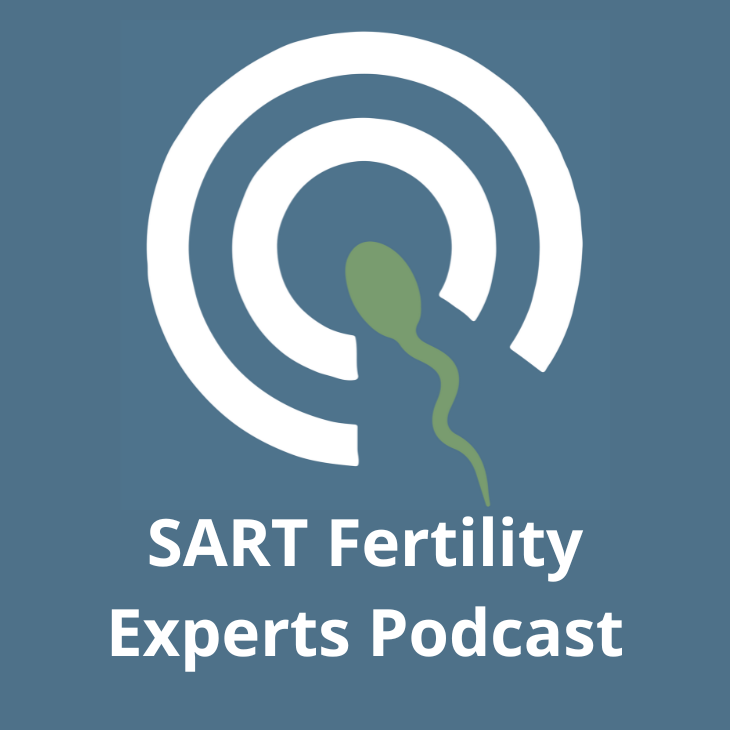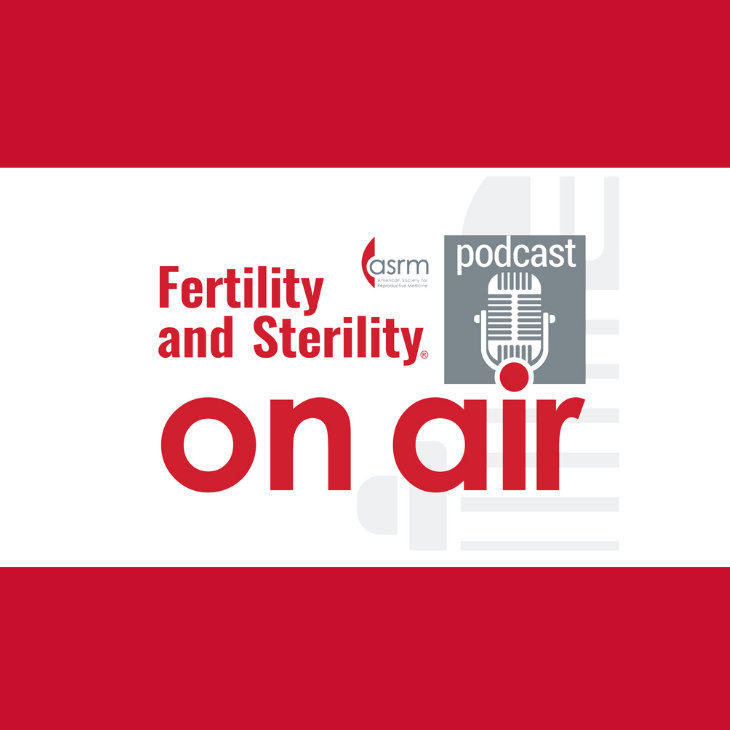
Transcript
The information and opinions expressed in this podcast do not necessarily reflect those of ASRM and SART. These podcasts are provided as a source of general information and are not a substitute for consultation with a physician. Welcome to SART Fertility Experts, a podcast that brings you discussions on important topics for people trying to build a family.
Our experts are members of SART, the Society for Assisted Reproductive Technology, an organization dedicated to ensuring you receive quality fertility care. So welcome to the SART podcast series. Today we'll discuss genetic and advanced reproductive technology.
It's an ever-changing and advancing field. My name is Dr. Cristin Slater. I'm a practicing reproductive infertility clinician and today we have a board certified and licensed genetic counselor to discuss genetic details in our field of advanced reproductive technology.
Jenna Miller has a BS degree in genetics and biotechnology. She has a master's of science degree in human genetics. Jenna travels North America educating healthcare providers about genomics within the ART field.
Welcome Jenna. Thanks for having me. Yes, it's a pleasure to discuss this exciting topic.
We have so much to talk about. So first we'll briefly touch on preconceptual carrier testing, which is done on intended parents. And then later we'll discuss the pregenetic testing, which is chromosome testing done on the embryos.
So Jenna, what is the preconceptual carrier testing and why would someone opt to do this or not opt to do this? Sure, Dr. Slater. So to understand what carrier screening is, you kind of have to take a step back a little bit and have a really brief genetics 101 lesson. So we have two copies of every gene in our bodies, right? And of those two copies of any particular gene, we get one from our mom and one from our dad.
And typically genetic conditions are caused by one, either one or both copies of a particular gene being non-functional or sub-functional. So being a carrier, as we call it, of a genetic condition means that first the genetic condition in question is typically what we would call recessive. That means that you really only need one of your two copies of a particular gene to be functional, to be a healthy individual.
The second copy is sort of a backup. So a carrier of a particular recessive genetic condition has one working and one non-working copy of a particular gene. And carriers of genetic conditions are typically healthy.
They typically have no symptoms of the conditions that they carry. It's the only issue with being a carrier is if two reproductive partners both carry the same recessive genetic condition, then there is a one in four chance for each child they have to be affected with that condition. So examples of that would be like cystic fibrosis or sickle cell disease, Tay-Sachs disease.
There are many examples. And actually, it's not at all uncommon to be a carrier of a genetic condition. It's estimated that everybody carries about three to five genetic conditions on average.
And so, you know, in the past, as a genetic counselor, I've counseled patients about being carriers for genetic conditions, and they're very surprised. They say, how is this possible? I've never heard of this. There's nothing like this in my family.
I'm so healthy. That's all common and typical. What I like to say to those patients is being a carrier of a genetic condition is just part of being human.
And again, it typically doesn't impact your health. Now, the purpose of carrier screening, which is a genetic test typically offered before or during pregnancy, is to identify if you are a carrier of a genetic condition. And recently, expanded carrier screening has become very common, quite commonplace, I would say.
And that is where we're testing for many different, we're talking on the level of a few hundred genetic conditions that a patient can be a carrier for. In the past, genetic testing was very expensive. So we had to be very selective with which genetic conditions we would screen people for.
And we did that, we selected those based on your ethnicity. So if you were of Sub-Saharan African descent, we would test you for sickle cell. If you were of European descent, then we would test you for cystic fibrosis.
If you were of East Asian descent, we would test you for thalassemias. And that worked, that was the best we could do at the time. But now that genetic testing is so much more sophisticated and just much more high yielding for a much lower cost, we're now able to screen everyone for lots of conditions.
And this is expanded or it's sometimes called pan-ethnic carrier screening. And one of the real benefits of expanded carrier screening is one, that you identify more carriers of conditions, not just the really common ones, but some of the more rare ones as well. But also it truly is a pan-ethnic test.
And they've apparently been getting better over the last several years in being truly representative of many different ethnic backgrounds. We live in a time where we don't always know where our ancestors came from. And so as a clinician, just looking at a person and trying to determine what their ethnicity is and which genetic condition we should screen them for, that's not, that's certainly a foolproof, that's not a foolproof method now.
And so expanded carrier screening is really an option for anyone who is planning a pregnancy or considering having a child in the future or anyone who is currently expecting. And it's a simple blood test. It's really commonly offered in the reproductive space.
Right. And that makes sense because we're trying to do this preconceptually. So you get as much information that you want.
And then, you know, our goal is to have a healthy live born. And, and, you know, it's very rare for both egg and sperm, probably 1% of the time to both be carriers for the same thing. But if they are, you know, if they opt to do genetic testing on the embryos, which is kind of a segue to a discussion we're gonna have soon, that there are options.
It's not just, okay, you know, your risk. Now, you know, your risk, and you can opt to take that risk, or you can opt to try to mitigate that risk. Exactly.
Dr. Slater, that's, that's actually a really good point. In the past, carrier screening was pretty much only offered to individuals who were already pregnant. But in recent years, there's been a push to offer it more often for those who are planning a pregnancy, because then you have more options if you and your partner or your whatever reproductive partner you've chosen.
If you know that you're both carriers of the same condition before pregnancy, then you have more options in terms of maybe doing in vitro fertilization and testing your embryos for that condition. Yeah, so it's great to be able to make decisions and feel good about your decisions. So now we'll shift gears and really discuss what the genetic world is exploding in our fertility world and discuss PGT.
So it's pre genetic testing, which is done on the embryos. The carrier testing is more done on intended parents looking for single gene disease. And then when you talk about PGT, where we're biopsying the embryos, just kind of a step back in vitro fertilization, what happens is we harvest the eggs, you know, from a woman, and then we collect the husband, the partners will collect sperm, will fertilize the egg, culture the embryos.
And on day five, six and seven, when the embryos become a blastocyst, then the intended parents have the option, okay, am I going to take these blastocysts and transfer them to the uterus? Am I going to freeze them and later transfer into uterus? Or am I going to do pre genetic testing on these embryos to get more information about these embryos, freeze them and later transfer? So, you know, as far as PGT, pre genetic testing, this is on the embryo, not the blood of the intended parents. And we'll go in take a deep dive into this. And so what is pre genetic screening? And, and, and you can describe the nomenclature of this.
And then, you know, why would someone opt or not opt to have this screening? Sure. So you brought up a good point there, which is the nomenclature. And this is, I think, something that we should really start with, because this is probably the first place where people can get confused about this type of testing.
So we're talking about genetic testing done on IVF embryos, right? And up until about 2017, this testing was called either PGS or PGD, that's pre implantation genetic screening, or pre implantation genetic diagnosis, and which nomenclature was used depended upon which type of testing was being done. In 2017, a number of societies got together and decided to change the nomenclature that we use in reproductive medicine for genetic testing done on embryos. And they created this new overarching acronym, which is PGT, pre implantation genetic testing.
And by the way, this nomenclature change was headed up by the World Health Organization in association with the American Society for Reproductive Medicine, and other societies, possibly even SART was involved in that. So PGT stands for pre implantation genetic testing, right genetic testing done on embryos before they implant pre implantation genetic testing. And then there is a hyphen and then one or two letters after PGT.
And that designation tells you what specific type of genetic testing is being done on those embryos. So the most common form of genetic testing done on embryos is PGTA. That's pre implantation genetic testing for aneuploidy.
Aneuploidy is a technical term for missing an extra chromosomes or chromosomal material in embryos. Chromosomes are these large pieces of DNA that we have in ourselves. And it's common for embryos to have extra or missing chromosomes, either whole chromosomes or pieces of chromosomes.
And the risk to have an embryo that is having a chromosome abnormality increases with maternal age. And this type of testing PGTA, this is what was previously called PGS. So some people still use the older nomenclature.
I mentioned both just so you know, whatever nomenclature your facility is using, so you can be on the same page as them. But typically, nowadays, we're using PGTA. Again, aneuploidy or chromosome abnormalities in embryos is common.
So PGTA is a test that's offered to anyone doing in vitro fertilization. And as we go on, I think we'll talk more about specific indications for PGTA. But I'll leave that for the moment while we go through and define the other two types of of PGT.
So pre-implantation genetic testing for monogenic conditions or PGTM. This is that testing that is an option for those couples we were talking about previously, who were both identified to carry the same genetic condition, if through expanded carrier screening, if a couple in that situation wanted to test their embryos for that particular genetic condition that they know they're at risk for, that would fall under the category of PGTM. Pre-implantation genetic testing for monogenic disorders.
So again, this is for individuals and families who know that they are at increased risk for a very specific single gene disorder running through the family. So that could be a recessive condition like we've talked about already, cystic fibrosis, sickle cell disease. It could also be a dominant condition where the parent themselves is affected and each of their children has a 50-50 chance to also be affected.
Those would be things like the hereditary cancer syndromes, for example, BRCA, hereditary breast and ovarian cancer syndrome, Huntington's disease, those sorts of conditions. And one thing that I will mention about PGTM for anyone who is considering this testing, as a patient, it's very important to be aware of the fact that every PGTM test is custom designed for your case, for the family in question. And so because of that, it typically takes quite a bit of time for a PGTM test to be ready for a patient to cycle.
So if a patient comes in and wants to pursue PGTM, it will probably be a few months before they're actually able to cycle and test their embryos, create embryos and then test them. One of the main reasons why it takes so long is because typically family members need to be involved in creating that testing where we're actually going to the couple's parents or other family members to help us create that custom test and testing those family members themselves. So that's all I'll say about PGTM for the moment.
And then let's quickly define PGTSR. In this case, SR stands for structural rearrangements. These are structural rearrangements of chromosomes.
Basically, you can think of PGTSR as embryo genetic testing for inherited chromosome abnormalities. So PGTA is testing for sporadic chromosome abnormalities that just happen all the time in embryos, regardless of family history. But PGTSR is specifically looking for inherited chromosomal rearrangements like things like translocations or deletions, duplications, inversions.
Anytime that a chromosome has a missing or an extra piece or two chromosome swap pieces, those things sometimes run in families. So PGTSR encompasses testing for those inherited chromosome abnormalities. And typically, PGTSR can be performed via a technology that's either similar to PGTA or PGTM, just depending upon the case.
We hope you're finding this episode of SART Fertility Experts helpful. Remember, for more information on this and related topics, visit www.sart.org and click on the tab labeled Patients. And now back to SART Fertility Experts.
Right. In all these situations, basically, you know, the embryo is all cultured with the in vitro cycle. And then about five of the cells are biopsied from the embryo.
And these are the cells that are more involved with the placenta and implantation, so not the cells that are designated to go to the fetus. So for the most part, a lot of patients will ask, you know, is this detrimental? Is my baby going to be born without a finger? Like, no, you know, this is pretty bread and butter technology for our embryologists who are skilled to do this all the time and in pretty low stress on the embryo. I mean, everything in life, if you, you know, implement some sort of change is a little stress, but overall, this is really kind of commonplace and low stress on the embryo.
And you do get information that at the end of the day will increase that implantation potential or give you information, you know, that can help you make decisions. Right. That's that's all very well stated, Dr. Slater.
Back in the early days of PGT or PGS at the time, it's been that this technology has been around for going on 30 years now. But in the early days, it was much more limited what we were able to test for. And we were often biopsying embryos, taking typically one, maybe even two cells out of an embryo after only three days of that embryo growing in the lab when it had about eight cells.
And more recently, in recent years, it was found that that has a more significant detrimental effect on the embryo when you sample it at that early stage when there aren't that many cells to begin with. So nowadays, we almost exclusively are biopsying embryos at what we call the blastocyst stage, which is typically arrived at between days five through seven of embryonic development. And as you said, we when we're biopsying an embryo, we're taking around five to 10 cells from the embryo for the purpose of genetic testing.
And those cells are coming from the part of the embryo that's called the trophectoderm. That's the part of the embryo that goes on to become the placenta, the support structures for the pregnancy. So we're not even touching the inner cell mass, which is the which is faded, those are the cells that are faded to become the fetus.
So we're not touching the cells that become the baby. And then once the embryo is biopsied, it is vitrified, it's it's quickly frozen at the lab, and it stays at the lab. And then those cells that were biopsied are sent to the genetics, the genetic testing lab for testing.
So that's another thing that I know a lot of patients want to know, are you sending my whole embryo away for genetic testing? No, the embryo stays in your your IVF lab with your embryologist safe, not safe and warm, but safe and cold. And, and it's just the cells that are that were biopsied that are sent for testing. And you also asked a good question, which is, is embryo biopsy detrimental to, at least at the at the blastocyst stage? Is there a detrimental effect there with biopsying the embryo? And what I typically say is that nothing that we do to embryos is without risk.
Nothing is 100% risk free. But as you said, in the hands of a skilled embryologist, the risks of blastocyst biopsy are expected to be very low, because that skill has been perfected over time. And again, comparing that to day three biopsy, where there are only about eight cells in the embryo, when we're biopsying a blastocyst, there are 100 or more cells in the embryo at that time.
So it's a much smaller proportion of the embryo overall. Right, so we're getting a snapshot of this embryo. So who, who is PGT most recommended for? Or what are the pros and cons? And you counsel people about this technology, like, who would you say it's most recommended for? And, what are the pros and cons of the pregenic testing? Right, so sticking with PGTA, the chromosome screening in embryos, probably the most common group for whom PGTA is indicated is women who are ages 35 plus.
We know that as a woman ages, she is more likely to make more embryos with chromosome abnormalities. Again, this is just part of being human. A woman is born with all of the eggs that she'll ever have, and they are sort of arrested, they're, they're stopped in a state of cell division until that egg is ovulated.
And the longer that it's sort of arrested in that state, the more likely it is to sort of make some of these errors with the chromosomes. So advanced maternal age is certainly one of the most common indications for PGTA. But there are others as well.
Another common one is patients who have had recurrent pregnancy loss, which ASRM currently defines as two or more pregnancy losses or miscarriages. We know that at least 50% of all first trimester miscarriages in the general population are due to chromosome abnormalities like the type that PGTA identifies. So if you are doing PGTA, and you identify an embryo that's called euploid, which means that all the cells in the biopsy that we took were normal, they had a normal number of chromosomes, that then at that point, you are essentially removing or drastically reducing the likelihood of having a miscarriage because of a chromosome abnormality.
Now there are other possible causes of miscarriage, but you're kind of, you're drastically reducing the risk for that one most common cause. So recurrent pregnancy loss is another common reason why a patient might consider PGTA. Now there are other reasons as well.
For example, if you would prefer to transfer one embryo at a time, undergo single embryo transfer, PGTA is really great for that. I know that when you're experiencing infertility, you want a baby as soon as possible. You already wanted one, maybe more than one right now, and it's costing you so much money to be able to conceive at this time.
And it sounds like a good idea to maybe transfer more than one embryo, maybe have a multiple pregnancy with two babies and kind of maybe get two babies for the price of one or what have you. But in the medical community, we know that there are a lot of risks both to babies and to mother associated with twin pregnancies. So in the field in recent years, in assisted reproductive medicine, we've really been pushing for more single embryo transfers, just putting one embryo back at a time.
Really the ideal for medical reasons is to have one baby per pregnancy, right? And so if you do PGTA and you have an embryo, again, that PGTA indicated is euploid or chromosomally normal, then you can feel more confident putting back just one embryo at a time because an embryo that is classified as euploid on PGTA has a much higher chance of being successful than an embryo that has a chromosome abnormality. I think that all this information is provided to patients, clinicians, and counselors, and the true intent is to improve outcomes and efficiency of timing to a healthy liveborn. And we hope this information was helpful for you and really look forward to future podcasts and maybe taking a deeper dive into genetics or even other developments in the reproductive technology.
So thank you very much. Thank you, Dr. Slater. Thank you for listening to SART Fertility Experts, your resource for information on IVF.
If you found this podcast useful, please like us on your favorite social media platform and tell your friends about us. For more family-building resources, visit www.sart.org slash patient-information or www.reproductivefacts.org
For more information about the Society for Assisted Reproductive Technology, visit our website at https://www.sart.org
Have a topic you'd like to hear? Tell Us!
Subscribe to the SART Fertility Experts Podcast on iTunes, Spotify, Google Play, or your favorite Podcast catcher.
Visit the podcast website and Start With SART!
SART Fertility Experts is part of the ASRM Family of Podcasts. Subscribe Now so you don't miss an episode!
SART Fertility Experts Podcast
SART Fertility Experts is an educational project of the Society for Assisted Reproductive Technology, this series is designed to provide up to date information about a variety of topics related to fertility testing and treatment such as IVF.
SART Fertility Experts - Military Families and Fertility
Active-duty individuals in the military sometimes face unique circumstances when seeking fertility care. Learn more with a former military fertility physician.
SART Fertility Experts - Q&A on Infertility
Infertility can create many questions for a patient. Listen to common questions and answers about infertility, egg freezing, and genetic testing.
SART Fertility Experts - Vanquishing Multiples
Learn how a variety of factors such as geography, race, and the availability of comprehensive infertility mandates affect access to effective infertility treatment.
SART Fertility Experts - Global Access to IVF and the Status of Women
Around the world, there are vast differences in the number of IVF cycles performed per capita. Learn why these differences exist.Genetic Screening/Testing
Find a Health Professional













